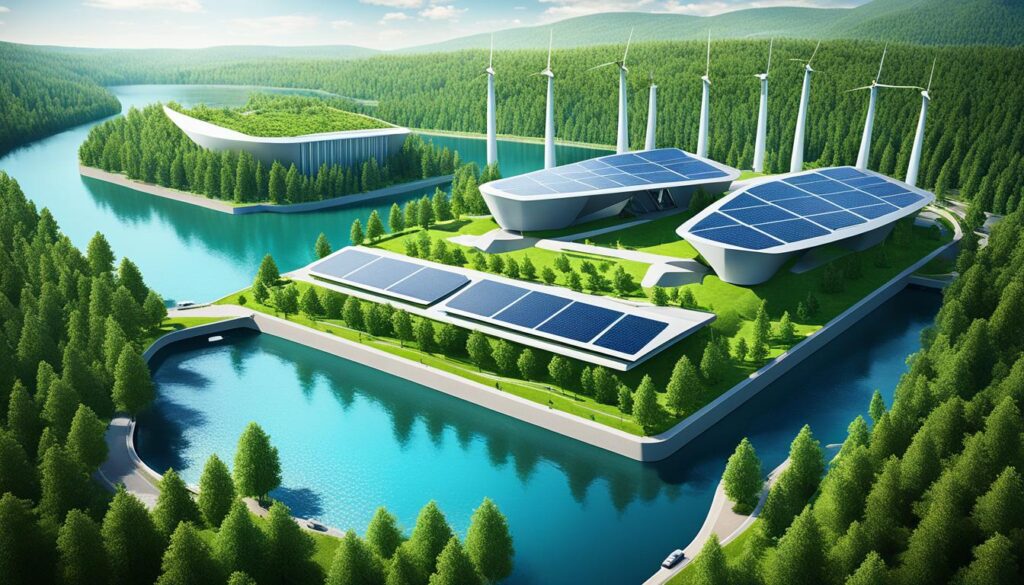In a world where fossil fuels are getting more expensive, and we’re fighting to cut down on greenhouse gases, big changes are happening in how we make electricity. Electricity companies need to make their power plants work better and spend less money while keeping the lights on. How do they find the best mix of saving money and making sure things run smoothly?
We’ll look at the newest ways to make power plants more efficient. And we’ll see how special software can help companies be both efficient and affordable. Plus, we’ll hear from top companies like GE and Toshiba about their cool power plant ideas.12
Key Takeaways
- The electric utility industry is integrating more sustainable resources into the energy mix to address rising fuel costs and emission reduction goals.
- Optimizing power plant efficiency and the cost of power production is crucial for utilities to maintain reliability and economic viability.
- Optimization software can help utilities balance efficiency and economics by providing recommendations on resource usage based on market conditions, demand, and other factors.
- Industry leaders like GE and Toshiba continue to innovate power plant technologies to deliver reliable and sustainable energy solutions.
- Renewable energy sources offer low operating costs but require backup resources to mitigate intermittency.
Introduction to Power Plants
Power plants make electricity from different energy sources. They are key to meeting the world’s growing need for electricity. Our homes, businesses, and cities all rely on them. They help drive our economy forward.3
Importance of Power Generation
Making electricity is vital for our way of life. It powers must-haves like healthcare and education. It also supports jobs and better living conditions. Having power that’s always there is crucial for moving ahead.3
Types of Power Plants
Power plants fall into two groups. There’s the usual kind, using fossil fuels and nuclear. Then, there are those using earth-friendly energy like wind and solar, known as renewable energy.4
Traditional power plants burn fossil fuels or split atoms to make steam. This steam turns turbines which create electricity. Non-traditional power plants work with nature’s own energy. They use things like wind and sunlight to produce electricity.43
Measuring Power Plant Efficiency
A power plant’s efficiency is all about its heat rate. This is how much energy is needed to make 1 kilowatt-hour (kWh) of electricity.5 When it comes to power plant talk, knowing the heat rate tells us a lot about efficiency. A lower heat rate means the plant works better.5
Heat Rate and Efficiency Calculation
To figure out a power plant’s efficiency, we take 3,412 British thermal units (Btu). This is what 1 kWh of electricity means. Then, we divide that by the heat rate to get a percentage.5 The U.S. Energy Information Administration helps us turn that heat rate into an efficiency score.5 They say it shows how the heat rate and efficiency go hand in hand.5
Traditional vs. Non-Traditional Power Plants
Old-school power plants use fossil fuels or nuclear power to make steam. This steam powers a turbine to create electricity.1 Nuclear power plants are usually about 33% efficient, but new ones can do up to 45%.1 Coal power plants work at 32% to 33% efficiency.1
Gas power plants are a bit better, with simple ones hitting 33% to 43%. But, if they’re combined, they can be over 60% efficient.1 Oil plants reach about 40% efficiency.1 Then, there’s hydro power, which stands out as the best with a 90% efficiency rate. This is because it directly turns water power into electricity.1
Plants like wind and solar are different. They don’t have to burn anything, so their efficiency measures how much natural energy they can turn into power.1 Wind plants range from 35% to 47% efficiency. Solar plants are between 18% and 25% efficient, with a trend of getting better.1 Technologies like using the ocean’s heat for power (OTEC) are not as good, managing just 6-8% efficiency.1
Efficiencies of Traditional Power Plants
Traditional power plants vary in efficiency based on their fuel. Nuclear plants work at about 33% efficiency, but some new ones can hit 45%.1 Coal-powered ones mostly run at 32% to 33% efficiency.1
Natural Gas Power Plant Efficiency
Simple cycle natural gas power plants are 33% to 43% efficient. But combined cycle ones can get over 60% by reusing hot exhaust gases.1
Oil Power Plant Efficiency
Oil power plants have about a 40% efficiency.1
Hydroelectric Power Plant Efficiency
Hydroelectric plants are the most efficient, running at 90%. They use water directly to turn the turbines.1
Efficiencies of Non-Traditional Power Plants
Non-traditional power plants using renewable sources might not be as efficient as old ones. However, they are cheaper to run. This is a big plus for them.
Wind Power Plant Efficiency
Wind power plants can be from 35% to 47% efficient.1 They use the wind’s energy to make electricity. So, they are a great renewable energy choice.
Solar Power Plant Efficiency
Solar power plants are about 18% to 25% efficient now,1 but this is getting better. With new tech, solar power will get more efficient and affordable. It will be a key player in our energy future.
Other non-traditional power plants, like OTEC, only work at 6-8% efficiency.1 They’re harder to use widely because they’re not as versatile.
Power Plant
The cost to make power is very important for companies that deliver it. Nuclear power is cheap to make, but it can’t change output quickly. Coal plants cost a bit more but can adjust power production better.6 Plants that use natural gas and oil are pricier but offer the most flexibility.6 Renewable sources, like wind and solar, are cheap to run. This is because they don’t need fuel. Yet, they can’t run all the time. They need other sources to back them up.6 Special software helps companies use their resources in the best way. It balances the need for efficiency with keeping costs low.
Cost of Producing Power
Power companies carefully think about how much it costs to make electric power. They want to offer electricity that is both dependable and affordable.6 The usual power sources, such as coal and natural gas, cost differently to produce power. Now, renewable sources like wind and solar are becoming more important in the energy world.
Traditional Resource Costs
Coal plants make a lot of the world’s power and are a bit pricier than nuclear plants. Yet, they can adjust power levels easier to meet demand changes.6 Natural gas and oil plants are more expensive to run. But they offer the most flexibility. This lets companies quickly change how much power they make.6
Non-Traditional Resource Costs
Renewable power from wind and solar is very cheap to use since they don’t need fuel.6 But, they can’t run all the time. They need support from other power sources for a steady supply.6 Modern software helps companies use different power sources efficiently. This way, they balance the cost with meeting demand.
| Power Source | Approximate Efficiency | Typical Production Costs | Flexibility |
|---|---|---|---|
| Nuclear | 33-45% | Low | Low |
| Coal | 32-33% | Moderate | Moderate |
| Natural Gas | 33-60% | High | High |
| Oil | ~40% | High | High |
| Wind | 35-47% | Low | Low |
| Solar | 18-25% | Low | Low |
Optimization for Efficient Power Generation
Utilities work hard to provide electricity that’s reliable and affordable. They use special software run by artificial intelligence to make things better. This software checks out things like what customers want, how well power plants use resources, and prices to suggest the best plan.7 It helps decide when and how much power to produce to save money and meet everyone’s needs.8
Balancing Efficiency and Economics
Utility companies have a lot on their plate. They need to make customers happy while managing power creation and distribution wisely.8 Thinking about what’s both efficient and affordable is key. By using optimization, these companies can lower risks and stay competitive.8
Artificial Intelligence and Optimization Software
Smart optimization software uses artificial intelligence to crunch big data and find the best ways to make power.8 For example, Gurobi has made its software much faster, helping solve problems quickly.8 Their software is designed to work well in many situations. Plus, they give fast, expert help when users have questions.8
| Key Optimization Factors | Impact |
|---|---|
| Plant Efficiency | A 15% improvement in overall plant efficiency was achieved.7 |
| Unplanned Downtime | There was a 30% reduction in unplanned downtime.7 |
| Maintenance Costs | Maintenance costs were decreased by 20%.7 |
| O&M Costs | O&M constitutes 80% of a facility’s life-cycle costs, and 80% of the total capital expended on a facility goes towards O&M.7 Potential O&M goals include maximizing asset value, reducing O&M costs, and enhancing user experiences.7 |
| Plant Reliability | The plant’s reputation as a reliable and sustainable energy provider was enhanced.7 Training and skill development for plant operators and maintenance personnel were key aspects of the optimization process.7 |
| Environmental Impact | Environmental compliance was achieved through the incorporation of advanced emission control technologies.7 |
GE’s Integrated Plant Approach
Being a top provider in power solutions, GE has over 60 years of experience. They design and make high-tech power generation systems. GE creates systems that fit different customer needs. These solutions include power for big and small operations, CHP, and designs to improve efficiency and dependability.9
Industrial and Utility Scale Power
GE is known for its top-notch gas turbines, steam turbines, generators, and balance of plant systems. They offer the best power plant solutions for many needs. GE helps customers see big improvements. These include less maintenance, more availability, lower inventory costs, and safer work environments.9
Combined Heat and Power (CHP)
GE goes beyond just generating power. They also offer efficient combined heat and power (CHP) solutions. These systems use leftover heat to boost overall energy use. CHP can make both power and heat from one fuel. It’s a reliable, flexible, and cost-saving option for many businesses.9
Plant Configurations
With a wide range of technologies, GE custom-makes power plants for its clients. Their tailored solutions work for industrial sites, large power stations, or CHP plants. GE’s focus on integration ensures these systems are efficient, reliable, and eco-friendly.9
Toshiba’s Thermal Power Generation Systems
Since 192710, Toshiba has led in making thermal power generation gear. They have a big scope of answers for steady and reliable energy worldwide.10
They back standard thermal power generation using different fossil fuels such as coal, oil, and natural gas. They also support advanced combined-cycle power generation. This method combines gas and steam turbines to be more efficient.10
Conventional Thermal Power Generation
Toshiba’s work in conventional thermal power dates back decades.10 Their systems are known for being reliable, efficient, and kind to the environment.10
They provide one-stop services for thermal power plants. This covers everything from R&D to upkeep, helping to cut down on costs.10
Combined-Cycle Power Generation
Besides traditional methods, Toshiba has also excelled in combined-cycle power generation. These systems are more fuel-efficient and produce less CO2 than traditional setups.10
Toshiba’s combined-cycle power solutions rank high globally in thermal efficiency.10
Major Thermal Power Generation Equipment
Toshiba focuses on creating high-efficiency steam turbines, generators, and top-notch control systems. These are made to be reliable, adaptable, and gentle on the planet.10
They are putting effort into bigger steam turbines and smaller systems for better efficiency. And they offer different-sized turbine generators. This includes hydrogen-cooled generators, upping efficiency and dependability.10
Toshiba’s control systems are vital for stable and effective power plant operation. They help with plant care and keeping up with rules.10
Toshiba is a known partner in the thermal power industry thanks to its vast experience and ongoing innovation. They offer trustworthy and sustainable energy solutions to tackle the world’s energy needs.1011
| Key Toshiba Thermal Power Generation Capabilities | Details |
|---|---|
| Conventional Thermal Power Generation | Highly-reliable, highly-efficient, and eco-friendly systems supporting a stable power supply worldwide10 |
| Combined-Cycle Power Generation | Achieve the world’s highest level of thermal efficiency, with lower fuel consumption and CO2 emissions10 |
| Steam Turbines and Generators | Developed for larger capacity, higher efficiency, and enhanced reliability, including hydrogen-cooled generators10 |
| Information and Control Systems | Ensure stable and efficient power plant operation, aiding in maintenance and compliance10 |
| Service and Support | Seamless services from R&D to maintenance, reducing costs for facilities and operations10 |
Conclusion
The U.S. electric utility industry faces big challenges. It must handle rising fuel costs and cut greenhouse gases. The key is to make power plants work better and smarter.12 Americans leads in using electricity more than any other country. About a fifth of our power comes from nuclear energy. Yet, worries about radiation and the halt of new nuclear plants push us toward wind, solar, and other renewables.12
By using smart software, companies can find the best power mix. Leaders in the field, such as GE and Toshiba, are always finding new ways. They make efficient gas and steam turbines, and whole plant solutions. This work brings stable, green energy choices for tomorrow.12 Today, solar, wind, and wave energy steadily grow. They are a smarter choice economically than new nuclear plants.12
The electric industry is changing for the better. It’s aiming to meet higher electricity needs while being kinder to the planet. Thanks to new tech and software, utilities can offer power that’s both reliable and eco-friendly.12,13,14
FAQ
What is the importance of power generation?
Power generation is key for running homes, businesses, and infrastructure. It also pushes economic growth forward.
What are the main categories of power plants?
There are traditional plants using fossil fuels or nuclear power. Then, there are non-traditional ones, using wind, solar, or hydro power.
How is the efficiency of a power plant measured?
A power plant’s efficiency comes from its heat rate. This term means the energy needed to make 1 kilowatt-hour (kWh) of electricity.
What are the typical efficiency ranges for different types of power plants?
Nuclear plants are usually about 33% efficient, going up to 45% in newer ones. Coal plants have rates around 32% to 33%. Simple cycle natural gas ones vary between 33% and 43%. Yet, combined cycle natural gas plants can get over 60% efficient. Oil plants hover around 40%, but hydroelectric ones are the most efficient at about 90%. For wind power, expect an efficiency from 35% to 47%. Solar plants are currently between 18% and 25%.
How do the costs of producing power vary between different power sources?
Nuclear power is cheap but not very flexible. Coal is a bit pricier but more adaptable. Plants running on natural gas and oil are costlier. They allow for more adjustments in output based on demand. Wind and solar are cheap to run since they don’t need fuel. However, they’re not always available, needing support from other sources.
How can optimization software help utilities balance efficiency and economics?
Optimization software, with the help of artificial intelligence, considers market conditions, demand, and resource availability. It looks at production costs to find the best way to use a utility’s energy sources. This software suggests how to manage resources to meet demand efficiently and cost-effectively.
What are some of the key features of GE’s and Toshiba’s power plant solutions?
GE brings over 60 years of experience in designing and making advanced power equipment. Their solutions cover needs from industrial to utility-scale power. They include CHP applications and various plant setups to boost efficiency and reliability. Toshiba, in contrast, focuses on both traditional and advanced power generation. This includes high-efficiency steam turbines and control systems, enhancing power plant efficiency.
Source Links
- https://www.pcienergysolutions.com/2023/04/17/power-plant-efficiency-coal-natural-gas-nuclear-and-more/
- https://www.siemens-energy.com/global/en/home/products-services/product-offerings/power-plants.html
- https://energyeducation.ca/encyclopedia/Power_plant
- https://www.realpars.com/blog/power-plant
- https://en.wikipedia.org/wiki/Power_plant_efficiency
- https://en.wikipedia.org/wiki/Power_station
- https://www.linkedin.com/pulse/optimizing-power-plant-performance-comprehensive-guide-operation-dm4rf
- https://www.gurobi.com/industry/optimization-for-the-power-and-utilities-industry/
- https://www.ge.com/digital/industry/power-generation
- https://www.global.toshiba/ww/products-solutions/thermal/products-technical-services/generation-technologies.html
- https://www.toshiba.com/taes/
- https://blogs.uoregon.edu/envs202nuclearpower/conclusion/
- https://nap.nationalacademies.org/read/4918/chapter/14
- https://www.un.org/esa/sustdev/publications/energy/chapter9.pdf



